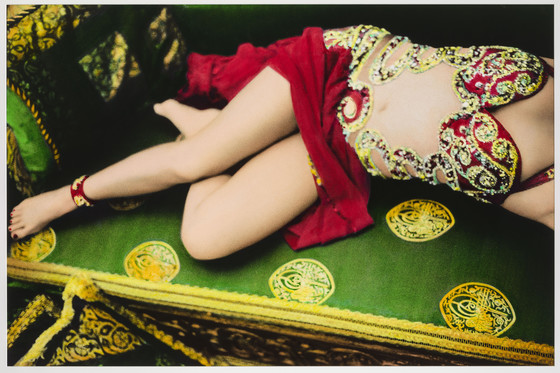Known for her fusion of Arabic, North African, and Western electronic music, Natacha Atlas is shown here in one of several portraits by Youssef Nabil in which he creates an anachronistic effect by han...
Known for her fusion of Arabic, North African, and Western electronic music, Natacha Atlas is shown here in one of several portraits by Youssef Nabil in which he creates an anachronistic effect by hand-painting the black-and-white print, harkening back to the glamorous photography of mid-twentieth-century Cairo. When Nabil met the singer, he knew instantly he wanted to photograph her as a kind of “Oriental tableau,” as a traditional belly dancer, inspired by the classic Egyptian movies he watched obsessively on television while growing up in Cairo. Although the pair’s friendship developed following the photo shoot, Atlas already trusted his instincts and he quickly arranged for the costume and props.
Here, the figure is cropped just below the shoulders, like a film closeup, with the camera reverentially focusing on Atlas’s tautly muscled torso and legs, perfectly suited to the subject, as the pop singer had performed as a belly dancer in London clubs earlier in her career. Supine, sensuous, and headless, she is ostensibly unaware of the viewer’s eyes upon her. But Atlas is not the woman trapped by the “male gaze” implicit in the Western fantasy of the Middle East, which presupposes a state of feminine vulnerability and passivity. Rather, she is formidable, with the tense energy and toned physique required of a dancer, both aware and in control of her sexuality.
The belly dancer went on to become an important theme in Nabil’s work in both still photography and video. His dancers are powerful, confident, and in charge, as in actress Salma Hayek’s potent performance in the video I Saved my Belly Dancer (2015). They are also exquisite in their sinuous movements, as in The Last Dance #I and # II (2012), two series of still images that capture the swirl of the dancer’s flowing gold costume. In contrast to the Orientalist trope of the belly dancer, for Nabil she activates both a remembered and an imagined memory of Egypt, of home.
More...
